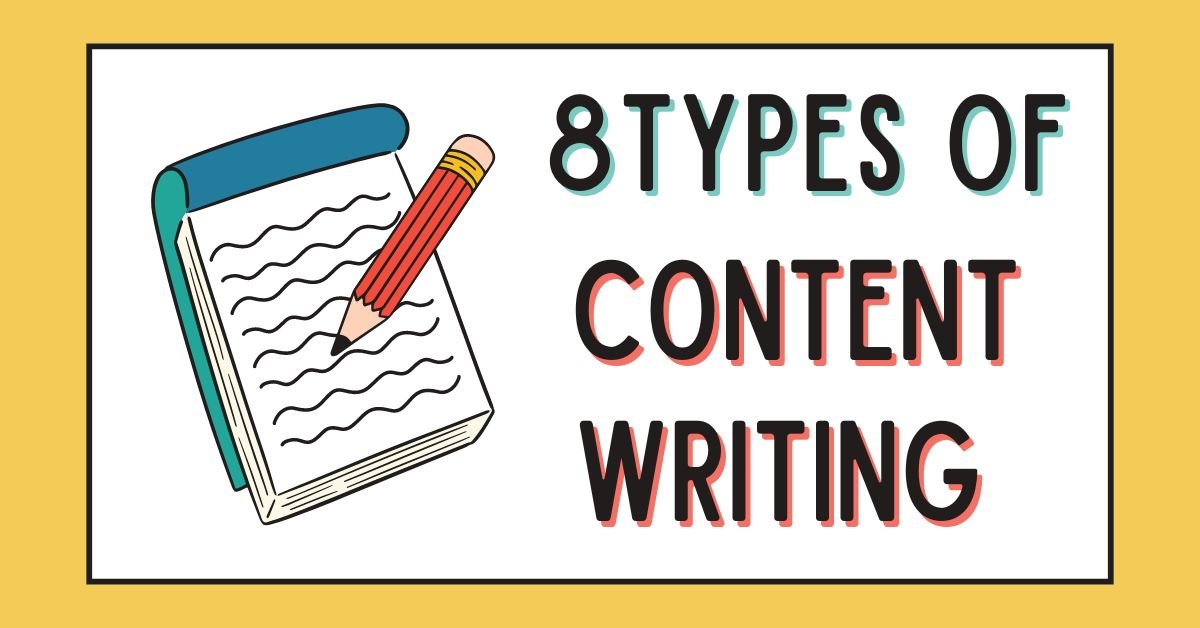Are you a digital marketer, content writer, or small business owner looking to enhance your content strategy? With so many different types of content writing, understanding which one to employ for specific goals can be a game-changer.
Introduction to Content Writing
In the modern digital environment, content writing is essential as it forms the foundation of online interaction. It facilitates audience connection for marketers, content producers, and company owners, increasing consumer engagement and conversion rates.
In addition to educating readers, good content engages them and fosters loyalty. You may increase the success and exposure of your company by converting infrequent visitors into loyal consumers by creating interesting tales and insightful content.
Overview of 8 The Different Types of Content
Below is an explanation of each of the 8 different types of content writing.

1. Blog Posts
Blog entries are an effective tool for content producers, marketers, and company owners. They provide a forum for the exchange of insightful information, the development of authority, and deeper audience connections. You may increase traffic, foster conversation, and develop a devoted following by writing well-written content.
Blog postings help you successfully express your message, whether you’re revealing industry trends, providing how-to tips, or sharing the narrative of your company. They complement your entire marketing plan and improve your internet visibility as well.

2. Articles
Blog postings are not the same as articles in a few respects. Articles are usually lengthier, more formal, and extensively researched. They are frequently used to present in-depth knowledge about a subject. They work well for news websites, white papers, and corporate reports where accuracy and legitimacy are important.
Blog postings, on the other hand, are more current and conversational, focusing on personal insights and instant audience participation. Blog postings are great for content producers and marketers since they foster community and increase traffic.

3. Social Media Posts
It’s important to know the specific criteria of each social media site to create posts that are engaging. If Instagram is all about visually attractive photos with brief descriptions, Twitter is all about short, powerful tweets. LinkedIn, on the other hand, favors longer-form material and professional insights.
Understanding these subtleties may help marketers, content producers, and company owners increase reach and engagement considerably. Adapting your strategy to each platform not only increases visibility but also strengthens your relationship with your audience.

4. Copywriting
Copywriting is an essential talent for marketers, content creators, and company owners who create sales-oriented material, such as landing pages and advertisements. Creating attention-grabbing text that encourages conversions may significantly impact your marketing campaigns.
In addition to selling, good sales copy interests the reader, conveys a narrative, and fosters trust. When writing an advertisement or creating a landing page, pay close attention to using language that is understandable and appealing to the requirements and wants of your target audience.

5. Technical Writing
Successful paperwork, manuals, and user guides must be created for every product. To make sure that their audience can readily grasp complicated material, marketers, content creators, and company owners rely on clear, succinct technical writing. Effectively written manuals not only improve customer happiness and lower support costs, but they also improve the user experience.
The work spent creating these resources pays dividends since it streamlines procedures and empowers users. Recall that establishing rapport and trust with your audience requires effective communication.

6. Creative Writing
Content producers, company owners, and marketers may all benefit greatly from creative writing. It enables you to write stories that captivate and connect with your audience. Storytelling has the power to enthrall readers and establish a deeper connection, whether you’re conveying a brand narrative or producing interesting material.
You may set your business apart from the competition and forge closer bonds with your target audience by including imaginative storytelling in your marketing plan. Genuine narratives imbue your brand with significance and memorability.

7. SEO Writing
SEO writing is essential in today’s digital environment to raise search ranks. Marketers, content producers, and company owners may increase their online presence and draw in more organic visitors by concentrating on relevant keywords.
Create interesting, keyword-rich content that speaks to your readers and naturally incorporates search phrases. Maintaining this equilibrium makes sure that your content is search engine optimized and valuable to viewers.

8. Email Writing
For marketers, content producers, and company owners, email writing is crucial, particularly for newsletters, drip campaigns, and promotional emails. Email engagement and conversion rates may be greatly increased by creating emails that are interesting and engaging.
Effective email communication helps to establish lasting bonds with customers and spur business expansion, whether you’re informing them of the most recent developments in your industry, providing unique offers, or nurturing leads via automated sequences. Now is the time to start writing emails that your audience will respond to!
If you want to know the benefits and tips for content writing, then read this article: 8 Benefits of Content Writing [+Tips for Success]

Target Audience
Understanding your target audience is crucial for creating effective content. Each type of content appeals to different segments of your audience.
Identifying the Intended Readership for Each Type
- Blog Posts & Articles: General audience, niche-specific readers
- Social Media Posts: Followers of brand pages, potential new followers
- Copywriting: Prospective customers, lead generation targets
- Technical Writing: Users of a product or service
- Creative Writing: Engaged readers, brand enthusiasts
- SEO Writing: Search engine users, targeted keyword audiences
- Email Writing: Subscribers, potential customers

Writing Style and Language
The tone and style of your writing can significantly impact its effectiveness.
Appropriate Tone, Style, and Language for Each Type
- Blog Posts & Articles: Informative, casual to formal
- Social Media Posts: Conversational, engaging, platform-specific
- Copywriting: Persuasive, compelling, concise
- Technical Writing: Clear, precise, instructional
- Creative Writing: Imaginative, descriptive, brand-aligned
- SEO Writing: Natural, keyword-integrated, reader-friendly
- Email Writing: Personal, direct, action-oriented

Key Elements
Important components like headlines, structure, and CTAs are essential to producing effective content. Good headlines attract readers’ attention, and a clean structure makes material readable for marketers, content producers, and company owners. Appealing images increase action, and compelling CTAs encourage it.
To foster confidence, include references and links to reliable sources. Making use of these elements improves the quality of your material and helps you establish a rapport with your audience, which increases the impact and memorability of your message.

Tools and Resources
Several tools can help you create high-quality content efficiently.
Suggesting Useful Tools for Content Writers
- Grammar & Spell Checkers (e.g., Grammarly)
- SEO Tools (e.g., Ahrefs, SEMrush)
- Content Planning (e.g., Trello, Notion)
- Research Tools (e.g., BuzzSumo, Google Trends)
- Writing Assistants (e.g., Jasper, Outwrite)
Conclusion
In today’s digital age, understanding the different types of content writing is crucial for any business. Knowing the advantages and applications of each kind will greatly improve your content strategy.
With the appropriate approach, tone, and resources, you can produce captivating content that draws readers in and promotes company expansion. In the ever-changing world of content creation, keeping ahead requires constant learning and adjustment.
Are you prepared to advance your content strategy? Explore these content writing areas in more detail to understand how they may change your company. If you want to know how to find keywords for content writing, then read this article: How to find keywords for content writing: 6 Simple Steps.
FAQs
What makes creative writing effective in marketing?
Storytelling and captivating narratives are the hallmarks of creative writing. It helps set your brand apart, builds a stronger bond with your target market, and gives your brand significance and memory.
What tools are recommended for content writers to improve their work?
Numerous tools, including grammar and spell checks (like Grammarly), SEO tools (like Ahrefs and SEMrush), content planning systems (like Trello and Notion), research tools (like BuzzSumo and Google Trends), and writing helpers (like Jasper Outwrite), can be helpful to content writers.
What are the 4 Cs of Content Writing?
The 4 Cs of content writing are Clarity, Consistency, Creativity, and Connection. These principles form the foundation of effective content creation and help ensure that your messages resonate with your audience.
Clarity: Clear writing avoids ambiguity and confusion, making it easy for your readers to understand your message. Use simple language, concise sentences, and logical structure to ensure that your content is accessible to all readers.
Consistency: Maintaining a consistent tone, style, and voice across all content builds a recognizable brand identity. Consistency also extends to the quality and frequency of your content, helping to establish trust and reliability with your audience.
Creativity: Bringing originality and imagination to your content can captivate your audience and set you apart from competitors. Creativity involves using storytelling, unique perspectives, and engaging formats to make your content stand out.
Connection: Establishing a connection with your readers fosters engagement and loyalty. Understanding your audience’s needs and preferences allows you to create content that resonates on a personal level, making your messages more impactful.


2 thoughts on “8 Types of Content Writing You Should Know”